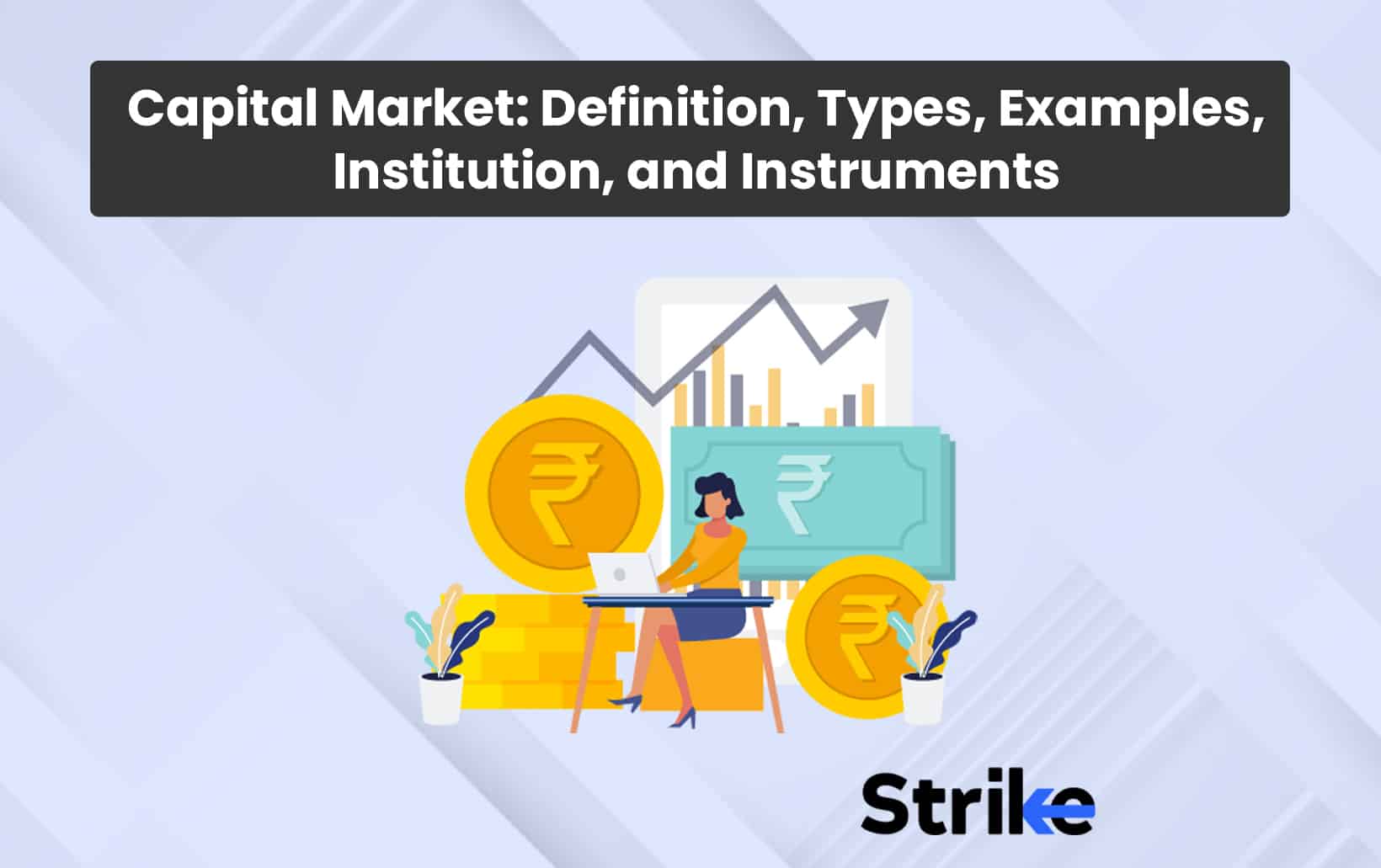
A capital market is a financial marketplace where individuals make investments for the long term and short term by buying and selling securities like debt or equities. A capital market facilitates the exchange of funds between the suppliers and those who seek it. Capital markets commonly comprise long-term debt and equity-based financial instruments, including stock and bond markets.
The capital market facilitates easy and efficient transactions by bringing together several suppliers, including banks and individual investors, and those seeking capital, such as governments, businesses, or individuals. A capital market includes both in-person and digital platforms.
The two main types of capital markets are primary and secondary capital markets. Primary capital markets are venues where companies sell stocks and bonds for the first time. Secondary capital markets are venues where stocks and bonds which were previously issued are exchanged between different investors. Both primary and secondary capital markets are overseen by regulatory bodies within different countries, such as the Securities and Exchange Commission (SEC) in the United States, the Financial Conduct Authority in the United Kingdom, or the Securities and Exchange Board of India in India.
The instruments that are exchanged in capital markets are mainly equities and debts, including stocks, mutual funds, treasury bonds, private sector bonds, etc. Currencies, foreign exchange, options, and contracts are also sometimes exchanged in capital markets. Therefore, examples of capital markets include stock markets, bond markets, options markets, and currency and foreign exchange markets.
The institutions and organizations commonly associated with capital markets include pension funds, life insurance companies, retirement funds, and charitable organizations in the form of suppliers. People purchasing vehicles and houses and governmental projects responsible for financing infrastructure development are also associated with the capital market as the users of the funds made available by the suppliers.
What is the Capital Market?
A capital market is a financial marketplace where long-term securities like debts and equities are exchanged or bought and sold between suppliers and those seeking capital. Capital markets facilitate efficient transactions by gathering suppliers and buyers together in one place. The suppliers in a capital market include banks, individual investors, and institutions handling pension and retirement funds or life insurance schemes.
The buyers in the capital market are mostly governments and governmental agencies involved in infrastructure development or individuals seeking to purchase houses or cars. The main securities that are exchanged in capital markets are stocks and bonds.
A capital market functions through the sale of financial assets like equities, bonds, options, currencies, and contracts. A capital market can be either an in-person platform or a digital platform. They facilitate the movement of capital from those willing to lend it to those who require it, making capital markets a key factor in the working of a nation’s economy.
How do Capital Markets work?
Capital Markets work through exchanging financial instruments, including stocks and bonds, between suppliers and buyers. Capital markets play an important role in the nation’s economy as it helps in the movement of capital from those who have money and are willing to lend to those who require money. The suppliers of capital markets include banks, individual investors, and institutions that offer pension or retirement funds or life insurance schemes.
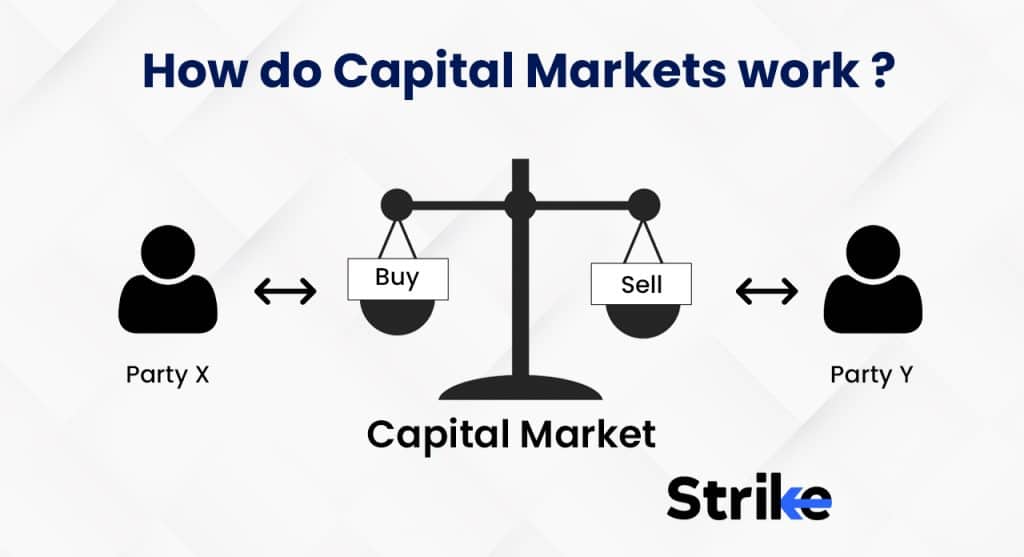
The buyers in a capital market include governments funding infrastructure developments, businesses seeking to expand, and individuals seeking to purchase houses or vehicles. Capital markets are designed to facilitate long-term investments by exchanging instruments, mainly stocks and bonds.
The most prominent capital markets usually include stock markets and bond markets. Stock markets are platforms where companies’ stocks, shares, and equity-based financial instruments are traded. Bond markets are venues where different types of debt-based securities are traded. Those interested in raising capital utilize these stock and bond markets to raise the capital they require.
Buyers obtain partial ownership of the issuing organization or company. They can earn returns through stock trading or any dividends that the issuing company may choose to offer if they purchase equities. However, in the case of bonds, buyers obtain the money directly and need to repay the bondholders the initial amount and a profit in a predetermined period of time.
What are the types of Capital Markets?
There are primarily two types of capital markets. The two types of capital markets are listed below.
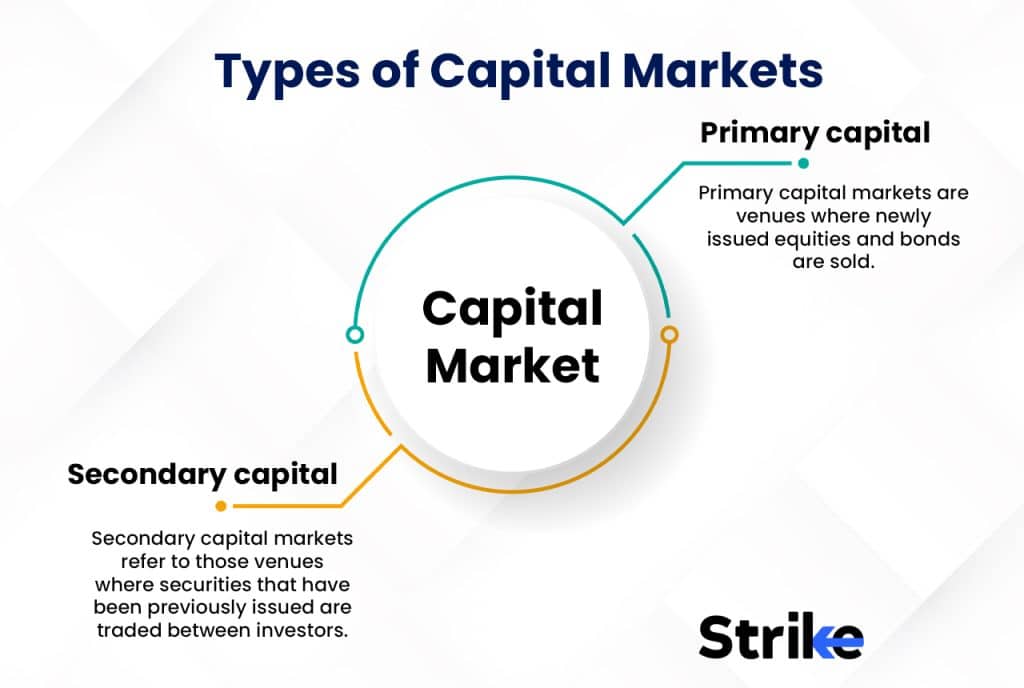
- Primary market
Primary capital markets are venues where newly issued equities and bonds are sold. Primary capital markets are also referred to as the new issues market. The issuing of stock or bonds in the primary market usually occurs through Initial Public Offerings (IPO). Any financial instrument issued on the primary market requires the prior approval of the regulatory authority in the country, such as the SEC in the US, the Bank of England in England, or the SEBI in India.
The main difference between purchasing securities from a primary market and a secondary market is that the securities on the primary market tend to get sold in a short duration and often in bulk. This is because investment bankers are keener on selling securities to large-scale investors who can make big purchases. Thus, small investors do not always get the opportunity to purchase from the primary market.
To illustrate an example of a primary capital market, let us assume that company X decides to issue 100 new shares. Before the IPO, X hires underwriting firms to determine the details of the IPO. Once the issue price is decided at, say, Rs 60 per share, investors can directly purchase the shares from X.
- Secondary Markets
Secondary capital markets refer to those venues where securities that have been previously issued are traded between investors. Secondary markets include all major stock exchanges, such as the New York Stock Exchange, the London Stock Exchange, the Bombay Stock Exchange, etc. The companies which issue the securities do not play a role in the trade of the securities in the secondary markets, as it is purely between the investors.
Secondary markets are of two types, those that utilize the open outcry system and those that utilize electronic trading platforms. In the open outcry system, buyers and sellers gather together in one place, and the securities are auctioned for sale. In electronic trading platforms, the trades are made electronically through dealer markets. Most exchanges today are fully electronic.
The main difference between primary and secondary markets is that the securities in the secondary market are more accessible to small investors than those in primary markets.
To illustrate an example of a secondary market, let us assume that investor A purchases the stocks of company C from another investor, D. The trade is made through an exchange S, which is a secondary market.
Which Financial Regulators oversee Capital Markets?
All transactions in capital markets are overseen by the country’s appointed regulatory bodies. The three most prominent regulatory bodies are listed below.
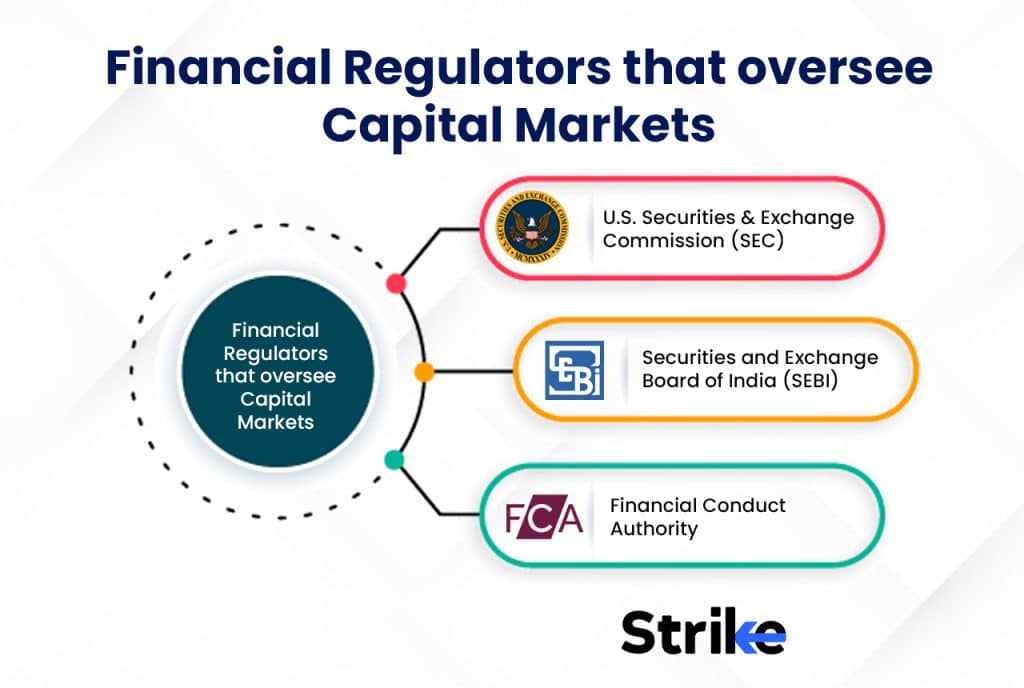
- U.S. Securities and Exchange Commission (SEC)
The US Securities and Exchange Commission (SEC) is a federal agency in the United States that regulates the functioning of the financial securities markets. The SEC is responsible for ensuring fairness and promoting ethical trading practices in all transactions that occur in the securities markets. It strives to protect investors from fraudulent and unethical practices and instil faith in trading systems. The SEC has the right to take civil action against those who violate its rules and regulations. It also has the power to work with the justice department in cases of criminal lawsuits.
The SEC regulates all trades made in primary and secondary capital markets. Securities that are issued in primary markets require prior approval from the SEC before the issuance. All companies that seek to issue securities on the primary market need to file statements with the SEC and obtain their approval before issuing the securities to the public.
In the case of secondary markets, too, the SEC oversees all the trades being made. The trades that are made through the secondary capital markets, whether open outcry systems or electronic systems, are monitored by the SEC to prevent fraudulent and unethical practices and protect the interests of the investors.
- Securities and Exchange Board of India (SEBI)
The Securities and Exchange Board of India is a regulatory body that controls India’s securities and commodities markets. The SEBI is a governmental body that comes under the Ministry of Finance. The SEBI was established in 1992 to protect the interests of investors and to prevent fraudulent and unethical trading practices. The SEBI also prescribes a code of conduct for intermediaries such as brokers and underwriters working as a part of the securities markets.
The SEBI plays a crucial role in the capital market by ensuring fairness and ethical trading practices. It also strives to instil confidence in the capital markets among people and helps in the development of the economy. The SEBI regulates the functioning of the capital market through strict monitoring and periodic audits. Inquiries and audits are conducted in all the stock exchanges, including the Bombay Stock Exchange and the National Stock Exchange.
- Financial Conduct Authority (FCA)
The Financial Conduct Authority is the regulatory body that oversees the financial markets in the United Kingdom. The FCA aims to promote fairness and transparency in the financial markets and protect investors from fraudulent and unethical trading practices. The FCA also promotes competition among the different markets competitors to establish a stable economic environment. The UK government gives the FCA complete power to enforce its rules and regulations, and the FCA also has investigative powers.
The FCA plays an important role in the capital market as all capital markets, such as the London Stock Exchange, come under the jurisdiction of the FCA. The FCA attempts to regulate transactions to contain the risk factors and prevent the occurrence of financial crises.
What are Examples of Capital Markets?
Four popular and well-known examples of capital markets are listed below.
- New York Stock Exchange (NYSE)
The NYSE is an example of a secondary capital market. The NYSE is one of the world’s largest capital markets. The NYSE comprises two types of secondary markets: the open outcry market and the electronic trading market. Both equities and bonds are available for trading on the NYSE. The SEC regulates the functioning of the NYSE.
- NASDAQ
The National Association of Securities Dealers Automated Quotations, whose acronym is Nasdaq, is a US-based secondary capital market that is fully electronic. The NASDAQ is the world’s largest electronic exchange for trading different types of securities, including equities and bonds. All trades made through NASDAQ are regulated and monitored by the SEC.
- London Stock Exchange
The London Stock Exchange is a leading capital market in the world. The London Stock Exchange is headquartered in London and is one of the busiest secondary capital markets in the world. Equity-based securities, as well as bonds, can be traded on the London Stock Exchange.
- The Bombay Stock Exchange (BSE)
The Bombay Stock Exchange is a leading Indian capital market. The BSE conducts all its transactions electronically. The BSE is one of Asia’s largest capital markets and is regulated by the SEBI. Equities and debt-based financial instruments and government securities are exchanged on the BSE.
What are the Institutions and Organizations associated with Capital Market?
The five main institutions and organizations that are associated with the capital market are listed below.
- Pension and Retirement fund institutions
Pension or retirement fund institutions are those institutions that organize schemes to provide retirement income to people. Pension or retirement fund institutions pool money from different sources and invest the money to earn profits. In a capital market, pension funds often act as suppliers, offering the capital as debt-based securities. The interest rate from the debt securities acts as a profit for the pension fund.
- Institutions associated with life insurance schemes
Institutions offering life insurance schemes act as suppliers in the capital market. The capital that is through premiums collected from those buying life insurance schemes is supplied through the capital market. By lending the premium capital, the institutions make returns through the interest rates. In case of an unfortunate event, a lump sum amount is paid to the family of the demised one.
- Charity Organisations
Charity organizations are organizations that work for particular social causes. These organizations obtain money in the form of donations and fundraising events. The money that is pooled is often invested or supplied in the capital markets to earn more returns on the principal amount.
- Expanding Businesses and Governments
Expanding businesses and governments utilize the capital market to borrow money required to expand their business plans or to fund infrastructure development. They purchase either equity in companies and make returns from those investments or purchase debt securities to obtain a huge initial amount of money. Since businesses or governments require massive amounts of capital right at the beginning of their expansion projects, they tend to obtain capital from debt securities more than equities.
What are the Instruments used in Capital Market?
The ten most commonly used instruments in the capital market are listed below.
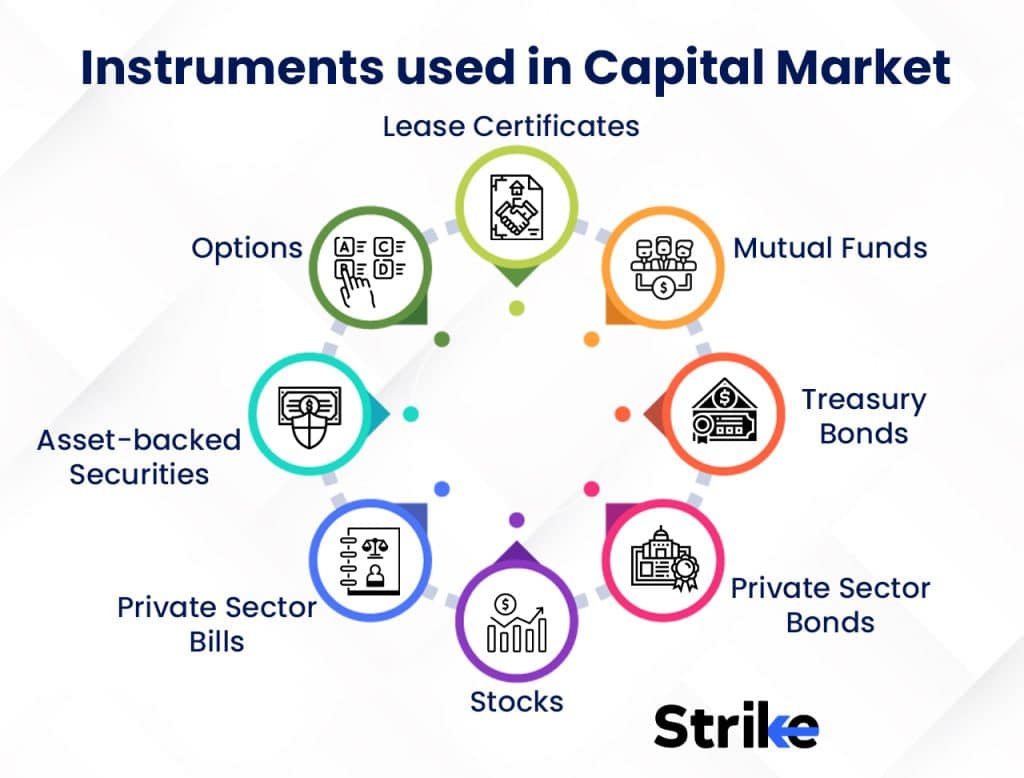
- Mutual Funds
Mutual funds are collective investment schemes that professional fund managers manage. Mutual funds pool money from different investors and investments are made in an investment portfolio comprising different capital market instruments such as stocks and bonds.
Unlike other instruments, a mutual fund exists in the form of a diverse portfolio where the investment is made in different financial instruments in the capital market, including equities, debts, contracts, etc.
Mutual funds are available for trading in capital markets. They as instruments that provide buyers with investment plans that involve less risk owing to their existence as a diversified portfolio. Investors looking for low-risk investment options which are affordable and managed by a professional manager tend to prefer mutual funds.
- Treasury Bonds
Treasury Bonds are debt securities issued by the governments of different nations. Treasury bonds are usually issued for long periods of time, such as 20 years or more. In treasury bonds, a periodic interest amount is paid to the bondholder apart from the principal amount, which is paid on maturity.
As instruments issued by the government, these instruments in the capital market involve minimal risk. They are extremely reliable, although the interest rate tends to be much lower than what is offered by bonds issued in the private sector.
Governments usually issue these bonds in capital markets to fund infrastructure development programs. Investors prefer Treasury bonds with low-risk appetites.
- Private Sector Bonds
Private sector bonds are debt securities issued by corporate companies. Private sector bonds are issued for short periods, such as one year or more. Like treasury bonds, private sector bonds also offer periodic payments apart from the return of the full principal amount at the end of the maturity period. Private sector bonds offer higher interest rates than treasury bonds but are riskier than treasury bonds.
In capital markets, private sector bonds are offered by corporates looking to raise capital for business expansion. Investors who are looking to invest their capital in raising more returns are the ones who buy private-sector bonds. Private sector bonds offer investors attractive interest rates even though the risk involved is higher than treasury bonds.
- Stocks
Stocks are financial securities representing ownership of a part of the issuing company. Stocks are also referred to as equities and are issued by corporates to fund their business operations. Smaller units of stock are known as shares.
Unlike other types of securities, stocks offer the stockholders ownership of the issuing company proportionate to the number of shares owned. Ownership gives stockholders voting rights and the right to receive dividends if they are being offered.
In a capital market, companies offer stocks for business operations or expansions. Investors who wish to invest their capital investment in stocks as they are a proven, well-performing form of investment. Stock markets, therefore, play a key role in capital markets, forming a very significant part of capital markets.
- Private Sector Bills
Private sector bills are bonds offered by corporates that have short maturity periods. Private sector bills are issued for durations ranging from four to fifty-two weeks. These securities are available in capital markets for investors who prefer shorter investment periods.
Corporations offer private sector bills in capital markets when they require quick capital for business expansions. However, as the duration is shorter, the amount obtained as interest may be less than that obtained from bonds of longer durations.
- Asset-backed Securities
Asset-Backed Securities(ABS) are a type of financial instrument that is based on underlying assets that are used as collaterals. ABSs are created by pooling assets and debts such as loans and leases. The assets in the form of loans, leases, and credit card balances held by different financial institutions, such as banks and lenders, are gathered together in a process known as secularization.
The investors take the interests, the principals, and the risk associated with the loans. Thus, lenders offer asset-backed securities in the capital market to pass on the risk to other investors. Investors in the capital market purchase these asset-backed securities as they offer higher returns than government bonds and form a good way to diversify their respective portfolios.
- Options
Options are financial instruments whose value is based on an underlying financial asset, such as stocks. Options offer the holder the opportunity to buy or sell the underlying assets at a predetermined price on or before the expiration of the option. Options are not obligatory; investors only need to exercise their options right, should they wish to do so. Investors use options to hedge against risks and to bet on speculations.
Options are available for purchase on capital markets for investors who seek to hedge their assets against risks. Out of all the other financial derivatives, options encompass the least risk and are therefore preferred by several investors.
- Lease certificates
A lease certificate is a security issued by companies that provide capital against leased or acquired assets. Lease certificates give holders the right to receive returns from leased-out assets. The purpose of issuing lease certificates is to sublease the assets to other investors to generate lease income.
- Futures contracts
Futures contracts are a type of financial derivate in the form of an agreement between two or more parties. Futures contracts are based on an underlying asset. It is an agreement wherein the concerned parties agree to buy or sell the securities at a predetermined price on a specific date. Unlike option contracts, futures contracts are obligatory.
Investors purchase contracts in the capital to hedge against future price fluctuations. They are also used to speculate on future price movements.
Investors interested in the capital market can choose from various instruments available depending on their investment needs and goals. Investors also use tools and algorithms to predict market movements while making their investment plans.
How do they forecast and analyze the movement of investments in the Capital Market?
The movements of investments in the capital market are forecasted using technical analysis and fundamental analysis. Technical analysis involves using mathematical tools, formulas, and algorithms to predict capital market movements. Technical analysis uses different branches of mathematics, including statistics and calculus, to make movement-predicting formulas and algorithms.
Stochastic calculus, a branch of mathematics that deals with stochastic processes, is frequently used in technical analysis. Stochastic processes refer to processes that have random and unpredictable outcomes. As capital market movements produce unpredictable outcomes, this branch of mathematics forms the basis of technical analysis. The Kalman filter based on the Stratonovich-kalman-bucy algorithm is another mathematical tool used to predict capital market price movements.
The Stratonovich-Kalman-Bucy algorithm is a code built on statistical and control theory that predicts outcomes with their uncertainties. It then uses a weighted average formula to estimate the most plausible outcome.
Fundamental analysis, on the other hand, involves the study and analysis of historical price data, company performance data, and current economic and financial conditions.
Why is Capital Market important to the economy?
The capital market plays an important role in the economy as it facilitates the movement of capital from the suppliers to those who require it. The capital market thus contributes to the functioning of a nation’s economy. Capital markets also help gather suppliers and those who require capital, including governments, businesses, and individuals, together in one place.
In what way do Capital Markets help investors?
Capital markets help investors by providing them with a place to buy or sell securities. Capital markets bring suppliers and lenders together, facilitating the movement of capital within the economy. The capital that is required for different purposes, from purchasing a house or car to infrastructure development and business expansion, is funded through the capital market.
Capital markets also make it possible for businesses to acquire capital with ease and reduced amount of risks, as they offer multiple choices, and each investor is able to choose the one that is best suited for their needs. From startups to bigger businesses to governments to individuals, the capital market benefits all investors, and all interested individuals can invest in capital markets. The process of investing in the capital market is simple and can be done electronically through trading and demat accounts.
How to invest in Capital Markets?
The four main steps to follow to invest in capital markets are listed below.
- Opening trading and demat accounts.
The first step to investing in capital markets is to open trading and demat accounts with a brokerage of your choice. A trading account is a platform through which you can buy or sell financial securities. A Demat account is a dematerialized account, where you hold the securities you own in digital format.
Securities purchased through primary and secondary capital markets are held in demat accounts. These accounts can be created online easily. The trading and demat accounts must then be linked to your bank account.
- Deciding whether to invest through the primary capital market or secondary capital market.
The second step to investing in the capital market is deciding, through reading and market analysis, how you wish to purchase your desired securities. Purchases can be made either directly from the primary capital market or indirectly through the secondary capital markets.
- Buying securities
The third step to investing in the capital market is purchasing the desired securities. The two ways to purchase securities are listed below.
- In order to buy securities through primary capital markets, applications must be made to the company issuing them directly. Purchasing securities through IPOs is done in this manner. The securities can be held in your demat account once the application is approved and the payments are made.
- In order to buy securities through secondary capital markets, you can use the trading account and make the purchase through an exchange of your choice.
- Managing your assets
The fourth and last step to investing in the capital market is managing your securities through trading and demat accounts. Trades can be made depending on each investor’s investment plans and goals. The gains obtained from the investment are deposited directly into the linked bank account.
Who can invest in Capital Markets?
Anyone interested in investing for extended periods can invest in capital markets. The individuals and institutions that commonly invest in capital markets are listed below.
- Individuals who seek investment options other than fixed deposits.
People who desire to invest their money in platforms other than fixed deposit options offered by all major banks often turn to the capital market. This is because the capital market offers a range of investment options with varying degrees of risk. Investors can choose from different types of financial instruments, and the returns from capital market investments tend to be invariably higher than those from bank fixed deposits.
- Individuals seeking to invest in retirement benefits.
The capital market also provides a venue for individuals to invest at least part of their retirement benefits. Since the returns from capital market investments tend to be greater than that from bank fixed deposits, investors have the opportunity to make greater returns through the capital market.
- Institutions that are associated with pension and retirement funds.
Institutions that offer pension and retirement funds to invest the pooled capital in capital markets. This is mainly due to the higher rate of returns and reduced risk involved in capital market investments.
- Organizations that offer various kinds of insurance.
Organizations that sell various kinds of insurance, including life insurance, health insurance, or car insurance, often, invest the premiums collected from individuals in the capital market. The higher rates of returns are limited risk factors that are the main reasons for these organizations to invest in capital markets.
Are there risks in investing through Capital Markets?
Investing in capital markets does involve a certain degree of risk. The degree of risk involved differs depending on the security in question. Debts are considered to be less risky than equities. Each investor can invest in the capital market according to his individual risk appetite.
When compared to money markets, capital markets are considered riskier as the maturity periods are longer. However, to raise vast amounts of capital, mainly to fund huge infrastructure development plans or business expansions.
What is the difference between Capital Markets and Money Markets?
The main difference between capital and money markets are listed in the table below.
| Capital Markets | Money Markets |
| Capital markets are financial markets where company and government securities are available for investing and trading for long-term purposes. | Money markets are financial markets where small-scale money dealers and bill brokers deal with financial securities purely for short-term purposes. |
| The instruments associated with capital markets are stocks, bonds, derivatives, foreign exchange, etc. | The instruments associated with money markets are bills, trade credit, commercial papers, etc. |
| The maturity period for the instruments is usually more than one year. | The maturity period for the instruments is usually less than one year. |
| The returns obtained from capital markets are higher. | The returns obtained from money markets are lower. |
| The assets in the capital market cannot be exchanged for cash very quickly as they are comparatively illiquid. | The assets in money markets are highly liquid as they can be exchanged for cash quickly. |
What is the difference between Capital markets and Bank Loans?
The primary difference between capital market and bank loans is in terms of the size of the amount that can be borrowed. Compared to the amount of capital that can be raised through capital markets, the amount that can be raised through bank loans is less.
Bank loans can also be more challenging to obtain, mainly as they are issued only after examining various factors such as income, credit score, and debt levels. Bank loans also need to be secured with collaterals, which is unnecessary for the capital market.








![85 Common Stock Market Terminologies for Dummies [Updated List for 2025] 12 85 Common Stock Market Terminologies for Dummies [Updated List for 2025]](https://www.strike.money/wp-content/uploads/2025/04/Popular-Stock-Market-Terms-for-Beginners-Banner.png)










No Comments Yet.